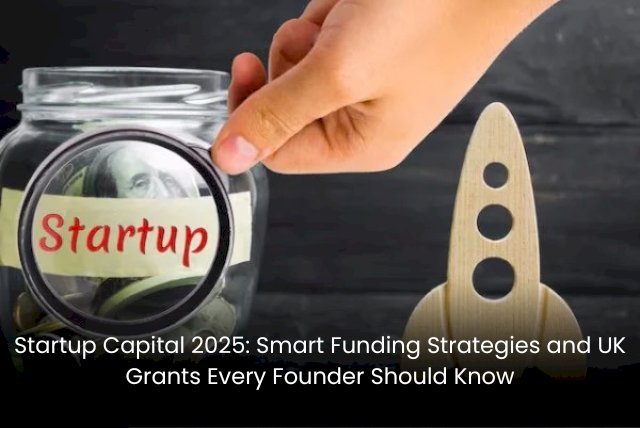Startup Capital 2025: Smart Funding Strategies and UK Grants Every Founder Should Know
Learn how to raise startup capital in 2025 with seed funding, venture capital, and UK startup grants. A practical guide for new entrepreneurs and small business owners.

Starting a business in 2025 has become easier than ever, thanks to digital tools, flexible work trends, and government-backed funding options. Yet, one thing remains at the core of every successful venture — startup capital. Whether you’re building an e-commerce brand, launching a SaaS platform, or opening a local café, understanding how to raise, manage, and spend your capital wisely is key to long-term success.
This updated 2025 guide explores everything you need to know about startup capital — including how much you really need, the best ways to raise funds, and the top UK startup grants and seed funding opportunities available right now.
What Is Startup Capital and Why It Matters in 2025

Image source: pixabay.com
Startup capital refers to the initial money needed to launch and run your business before it becomes profitable. It covers expenses such as market research, product development, branding, licensing, and marketing. In simple terms, it’s your financial runway that keeps the lights on while your business gains traction.
According to a 2025 report by CB Insights, 38% of startups fail due to insufficient funding or cash flow mismanagement. With inflation still hovering around 3.8% in the UK, and operational costs for software and logistics rising globally, careful financial planning has never been more critical.
Startup capital gives entrepreneurs breathing space — allowing them to make strategic decisions instead of rushing toward short-term revenue. The right amount of capital ensures your business survives the crucial first year, supports growth, and positions you for future investment rounds.
Types of Startup Capital and Seed Funding Explained
Before you begin raising capital for startup companies, it’s essential to understand the different forms of funding available. Each type suits a different stage in your business journey.
1. Seed Capital for Startups
This is the first formal round of funding that helps you turn an idea into a working prototype or product. Seed capital for startups often comes from angel investors, friends, or early-stage funds. It’s typically used for research, proof of concept, branding, and building a minimum viable product (MVP).
For example, a fintech founder in London might secure £50,000 in seed funding to develop an app, conduct user testing, and validate market demand before scaling.
2. Working Capital
Once your business is up and running, working capital covers day-to-day operations like payroll, rent, and inventory. Maintaining healthy working capital ensures consistent cash flow and operational stability.
3. Growth Capital
When your startup gains traction, you’ll need growth capital to expand — whether that’s hiring staff, launching new products, or scaling marketing. This stage often attracts venture capital for startup business opportunities from established investors.
4. Bridge Capital
Bridge funding serves as temporary financing between major funding rounds. It helps businesses maintain momentum while preparing for their next raise or revenue milestone.
5. Equity vs. Debt Capital
-
Equity Capital involves selling shares to investors in exchange for funding — common in startups with high growth potential.
-
Debt Capital comes through loans or credit facilities that must be repaid, typically with interest.
Understanding these options helps you choose the right balance between maintaining ownership and securing enough capital to grow.
How Much Startup Capital Do You Need in 2025?
There’s no universal number — your startup capital depends on your industry, business model, and goals. But updated 2025 estimates offer a helpful guide:
| Business Type | Estimated Capital (GBP) | Notes |
|---|---|---|
| Freelance / Consulting | £1,000 – £3,000 | Software, branding, marketing tools |
| Dropshipping Store | £800 – £2,500 | Shopify setup, ads, domain |
| E-commerce Brand | £5,000 – £15,000 | Product design, packaging, marketing |
| SaaS / App Startup | £20,000 – £150,000 | Developer costs, MVP creation |
| Local Café / Retail | £25,000 – £80,000 | Lease, staff, equipment |
| Franchise Business | £50,000 – £250,000 | Franchise fees, licenses |
| AI or Automation Startup | £30,000 – £200,000 | Compute resources, model training |
Tip: Always maintain at least 6–12 months of operating expenses as a financial buffer. Include a contingency fund (10–15%) for unexpected costs like market shifts or compliance requirements.
Raising Capital for Startup Companies in 2025

Image source: pixabay.com
The funding landscape has evolved rapidly. Entrepreneurs today have more creative, digital, and flexible funding routes than ever before.
1. Personal Savings
The most straightforward option — using your own savings gives you full control and avoids debt or equity dilution. This is ideal for freelancers, side hustlers, and micro-businesses.
2. Friends and Family
Personal networks can provide early financial support, but it’s important to have a written agreement outlining repayment or equity terms. Treat it like a professional arrangement to avoid future disputes.
3. Bank and Fintech Loans
Traditional bank loans remain reliable for proven business models. However, newer fintech lenders offer faster, more accessible alternatives with competitive rates. In 2025, platforms like Funding Circle, Tide, and Starling Bank provide business loans tailored for UK startups.
4. Angel Investors
Wealthy individuals who invest personal funds in exchange for equity. Besides money, they often bring mentorship and industry connections. Websites like Angel Investment Network UK and SeedLegals connect founders with potential angels.
5. Venture Capital for Startup Business
Venture capital for startup business models remains one of the most powerful funding routes for scalable tech, SaaS, or AI-driven ventures. UK-based VC firms such as Octopus Ventures, Balderton Capital, and Seedcamp actively fund high-potential startups.
Venture capital typically comes in larger sums (£250,000+), and investors expect a clear growth plan and exit strategy.
6. Crowdfunding
Crowdfunding lets you raise capital while validating your idea. Platforms like Crowdcube, Seedrs, and Kickstarter allow everyday investors to fund innovative projects in exchange for rewards or equity. It’s a great option for consumer-facing brands and creators.
Government Grants and Start Up Funding UK Options
If you’re based in the UK, there’s great news — the government offers multiple UK startup grants and start up business grants UK founders can apply for in 2025. These grants often don’t require repayment, making them a smart way to minimize risk.
Top UK Startup Grants and Programs (2025)
| Program Name | Funding Type | Eligibility / Purpose |
|---|---|---|
| Start Up Loans (British Business Bank) | Loan (up to £25,000) | New entrepreneurs aged 18+ starting in the UK |
| Innovate UK Smart Grants | Non-repayable Grant | Tech, sustainability, or AI-driven startups |
| Prince’s Trust Enterprise Programme | Grant & Mentorship | Entrepreneurs aged 18–30 |
| Local Enterprise Partnerships (LEPs) | Regional Funding | Business support across English regions |
| Scottish EDGE | Grant & Loan Mix | Scotland-based innovative startups |
| Welsh Government Start-Up Grant | Grant | New Welsh businesses under 12 months old |
Most grants require a solid business plan, proof of innovation, and a clear financial forecast. Applying early and tailoring your proposal to each program increases your chances of approval.
How to Spend Your Seed Capital Wisely
Once you’ve secured your seed capital for startups, it’s crucial to manage it strategically. Many new founders burn through funding too quickly without clear ROI. The key is to spend on what truly drives growth.
Smart Spending Areas
-
MVP Development: Build a simple, testable version of your product to validate market demand.
-
Customer Acquisition: Focus on affordable, high-return marketing such as SEO, email campaigns, and social media ads.
-
Essential Tools: Use cost-efficient digital tools like QuickBooks for accounting, Trello for project management, and HubSpot for CRM.
-
Hiring Key Talent: Invest in critical skills like development, design, or marketing rather than expanding too quickly.
-
Legal & Compliance: Register your company, secure trademarks, and ensure GDPR compliance if operating in the UK or EU.
Avoid Overspending On
-
Premium office spaces or expensive branding before achieving revenue.
-
Full-time hires when part-time or freelance help would suffice.
-
Large ad campaigns without data-backed targeting or funnels.
A good rule of thumb: allocate 70% of your startup capital toward revenue-generating activities and 30% toward operational and legal necessities.
Real-World Example: How Startups Allocate Their Capital
| Expense Category | E-commerce Business | Tech Startup (SaaS) |
|---|---|---|
| Product / Development | £5,000 | £25,000 |
| Marketing & Sales | £3,000 | £8,000 |
| Legal & Licenses | £1,000 | £1,500 |
| Team & Contractors | £2,000 | £10,000 |
| Tools & Software | £1,200 | £3,500 |
| Reserve (6–12 months) | £6,000 | £15,000 |
| Total | £18,200 | £63,000 |
This table illustrates how seed funding is distributed differently depending on business type. Service-based businesses can start lean, while tech ventures require larger upfront investment for development.
How to Calculate Your Startup Capital
You can use a simple formula to estimate your required funding:
Startup Capital = Setup Costs + (Monthly Costs × 6–12) + Contingency (10–15%)
Example:
Setup Costs: £8,000 (branding, licenses, tools)
Monthly Costs: £3,000
Runway: 6 months = £18,000
Contingency: £2,500
Total Startup Capital = £8,000 + £18,000 + £2,500 = £28,500
This calculation ensures you have enough to survive early challenges without running out of cash.
The Future of Startup Funding: AI and Digital Finance (2025)
In 2025, artificial intelligence and fintech innovation are transforming how founders access and manage capital. AI-driven credit scoring tools like Lendflow, Bluevine, and Clearco analyze revenue patterns to offer instant funding decisions.
Meanwhile, AI-based budgeting tools help startups predict expenses, optimize spending, and plan funding rounds with greater accuracy.
These technologies make raising capital for startup companies faster, fairer, and more data-driven than ever.
Conclusion: Build a Financially Strong Business in 2025
Startup capital is more than just money — it’s the foundation that determines your business’s survival and growth. By securing the right mix of seed capital, venture capital for startup business, and UK startup grants, founders can reduce risk and build sustainable momentum.
In 2025, the smartest entrepreneurs aren’t just chasing funding — they’re mastering how to use it wisely. Whether you bootstrap your idea or tap into government-backed start up funding UK programs, the key is to plan smart, spend strategically, and keep a close eye on cash flow.
A well-funded business can launch — but a well-managed business can thrive.
Read Also: Top Venture Capital Startups
FAQs About Startup Capital and Business Funding (2025)
1. What is startup capital and why is it important for new businesses?
Startup capital is the initial money needed to launch and run a business before it generates revenue. It covers key expenses such as product development, branding, marketing, and operations. Having enough startup capital ensures financial stability, allowing founders to focus on growth rather than short-term survival.
2. How much startup capital do you need to start a business in 2025?
The amount of startup capital required depends on your business model and industry. In 2025, a small service-based business might start with £1,000–£5,000, while a tech startup or SaaS venture could need between £20,000 and £150,000. Always plan for at least six months of operational costs and a 10% contingency fund.
3. What are the best ways to manage startup capital effectively?
To manage startup capital effectively, track expenses with accounting tools like QuickBooks or Xero, create a lean monthly budget, and prioritize spending on essential growth areas like customer acquisition and product improvement. Avoid unnecessary overheads, and maintain a financial buffer for unexpected costs.
4. Can a business start with low or no startup capital?
Yes, some businesses — especially service-based or online models — can start with little or no startup capital. Freelancing, consulting, content creation, or dropshipping require minimal upfront costs. Focus on using free tools, organic marketing, and reinvesting early revenue for gradual growth.
5. What is seed capital and how does it help startups grow?
Seed capital for startups is the first formal investment used to turn an idea into a working product or service. It helps fund market research, prototype development, and early marketing. Seed funding gives startups the resources to validate their business model before seeking larger investments.
6. How can new entrepreneurs raise capital for startup companies in 2025?
In 2025, new entrepreneurs can raise capital for startup companies through multiple sources — personal savings, angel investors, venture capital firms, crowdfunding, and UK startup grants. Platforms like Seedrs, Crowdcube, and Funding Circle make it easier to connect with investors and raise early-stage funds.
7. What is venture capital and how does it fund startup businesses?
Venture capital for startup business models involves investors providing large sums of money in exchange for equity. This funding supports high-growth startups, especially in tech, AI, and SaaS sectors. VC investors not only bring money but also mentorship, connections, and business expertise.
8. What are the top UK startup grants available in 2025?
Top UK startup grants in 2025 include Innovate UK Smart Grants, Prince’s Trust Enterprise Programme, and Start Up Loans from the British Business Bank. These programs support innovation, sustainability, and youth entrepreneurship with grants or low-interest loans that often don’t require repayment.
9. What are the main sources of start up funding in the UK?
The main start up funding UK options in 2025 are:
-
Government programs like Start Up Loans and Innovate UK.
-
Private investors and angel networks.
-
Crowdfunding platforms (Seedrs, Crowdcube).
-
Business loans from fintechs such as Starling Bank or Tide.
These sources cater to both early-stage and scaling businesses.
10. What is seed funding and when should startups seek it?
Seed funding is the first stage of external investment used to grow a startup beyond the idea phase. Founders typically seek seed funding once they have a clear concept, prototype, or early user base. In the UK, leading seed investors include Seedcamp, Ascension Ventures, and Octopus Ventures.

















